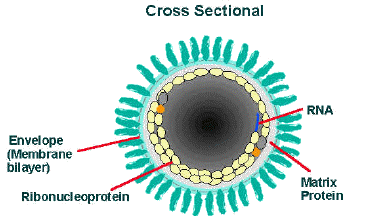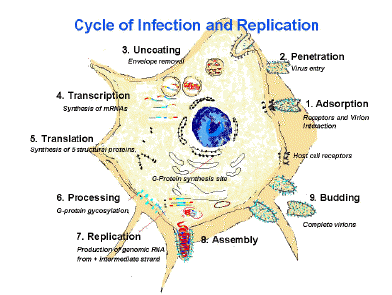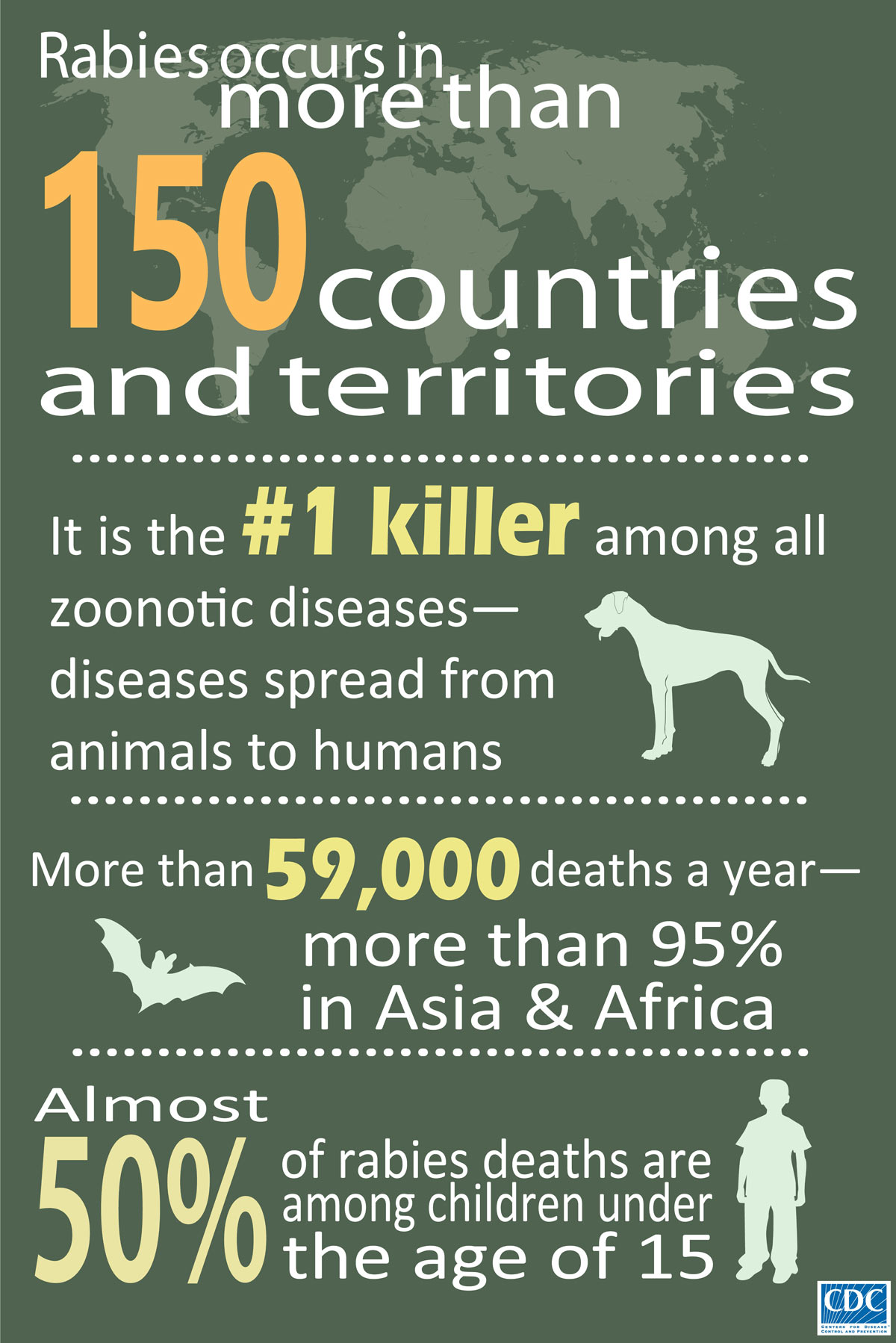Archive for the ‘Rabies’ Category
CDC recommendations to healthcare providers treating patients in Puerto Rico and USVI, as well as those treating patients in the continental US who recently traveled in hurricane-affected areas during the period of September 2017 – March 2018.
Wednesday, October 25th, 2017Advice for Providers Treating Patients in or Recently Returned from Hurricane-Affected Areas, Including Puerto Rico and US Virgin Islands
Distributed via the CDC Health Alert Network
October 24, 2017, 1330 ET (1:30 PM ET)
CDCHAN-00408
Summary
The Centers for Disease Control and Prevention (CDC) is working with federal, state, territorial, and local agencies and global health partners in response to recent hurricanes. CDC is aware of media reports and anecdotal accounts of various infectious diseases in hurricane-affected areas, including Puerto Rico and the US Virgin Islands (USVI). Because of compromised drinking water and decreased access to safe water, food, and shelter, the conditions for outbreaks of infectious diseases exist.
The purpose of this HAN advisory is to remind clinicians assessing patients currently in or recently returned from hurricane-affected areas to be vigilant in looking for certain infectious diseases, including leptospirosis, dengue, hepatitis A, typhoid fever, vibriosis, and influenza. Additionally, this Advisory provides guidance to state and territorial health departments on enhanced disease reporting.
Background
Hurricanes Irma and Maria made landfall in Puerto Rico and USVI in September 2017, causing widespread flooding and devastation. Natural hazards associated with the storms continue to affect many areas. Infectious disease outbreaks of diarrheal and respiratory illnesses can occur when access to safe water and sewage systems are disrupted and personal hygiene is difficult to maintain. Additionally, vector borne diseases can occur due to increased mosquito breeding in standing water; both Puerto Rico and USVI are at risk for outbreaks of dengue, Zika, and chikungunya.
Health care providers and public health practitioners should be aware that post-hurricane environmental conditions may pose an increased risk for the spread of infectious diseases among patients in or recently returned from hurricane-affected areas; including leptospirosis, dengue, hepatitis A, typhoid fever, vibriosis, and influenza. The period of heightened risk may last through March 2018, based on current predictions of full restoration of power and safe water systems in Puerto Rico and USVI.
In addition, providers in health care facilities that have experienced water damage or contaminated water systems should be aware of the potential for increased risk of infections in those facilities due to invasive fungi, nontuberculous Mycobacterium species, Legionella species, and other Gram-negative bacteria associated with water (e.g., Pseudomonas), especially among critically ill or immunocompromised patients.
Cholera has not occurred in Puerto Rico or USVI in many decades and is not expected to occur post-hurricane.
Recommendations
These recommendations apply to healthcare providers treating patients in Puerto Rico and USVI, as well as those treating patients in the continental US who recently traveled in hurricane-affected areas (e.g., within the past 4 weeks), during the period of September 2017 – March 2018.
- Health care providers and public health practitioners in hurricane-affected areas should look for community and healthcare-associated infectious diseases.
- Health care providers in the continental US are encouraged to ask patients about recent travel (e.g., within the past 4 weeks) to hurricane-affected areas.
- All healthcare providers should consider less common infectious disease etiologies in patients presenting with evidence of acute respiratory illness, gastroenteritis, renal or hepatic failure, wound infection, or other febrile illness. Some particularly important infectious diseases to consider include leptospirosis, dengue, hepatitis A, typhoid fever, vibriosis, and influenza.
- In the context of limited laboratory resources in hurricane-affected areas, health care providers should contact their territorial or state health department if they need assistance with ordering specific diagnostic tests.
- For certain conditions, such as leptospirosis, empiric therapy should be considered pending results of diagnostic tests— treatment for leptospirosis is most effective when initiated early in the disease process. Providers can contact their territorial or state health department or CDC for consultation.
- Local health care providers are strongly encouraged to report patients for whom there is a high level of suspicion for leptospirosis, dengue, hepatitis A, typhoid, and vibriosis to their local health authorities, while awaiting laboratory confirmation.
- Confirmed cases of leptospirosis, dengue, hepatitis A, typhoid fever, and vibriosis should be immediately reported to the territorial or state health department to facilitate public health investigation and, as appropriate, mitigate the risk of local transmission. While some of these conditions are not listed as reportable conditions in all states, they are conditions of public health importance and should be reported.
For More Information
- General health information about hurricanes and other tropical storms: https://www.cdc.gov/disasters/hurricanes/index.html
- Information about Hurricane Maria: https://www.cdc.gov/disasters/hurricanes/hurricane_maria.html
- Information for Travelers:
- Travel notice for Hurricanes Irma and Maria in the Caribbean: https://wwwnc.cdc.gov/travel/notices/alert/hurricane-irma-in-the-caribbean
- Health advice for travelers to Puerto Rico: https://wwwnc.cdc.gov/travel/destinations/traveler/none/puerto-rico?s_cid=ncezid-dgmq-travel-single-001
- Health advice for travelers to the U.S. Virgin Islands: https://wwwnc.cdc.gov/travel/destinations/traveler/none/usvirgin-islands?s_cid=ncezid-dgmq-travel-leftnav-traveler
- Resources from CDC Health Information for International Travel 2018 (the Yellow Book):
- Post-travel Evaluation: https://wwwnc.cdc.gov/travel/yellowbook/2018/post-travel-evaluation/general-approach-to-the-returned-traveler
- Information about infectious diseases after a disaster: https://www.cdc.gov/disasters/disease/infectious.html
- Dengue: https://www.cdc.gov/dengue/index.html
- Hepatitis A: https://www.cdc.gov/hepatitis/HAV/index.htm
- Leptospirosis: https://www.cdc.gov/leptospirosis/
- Typhoid fever: https://www.cdc.gov/typhoid-fever/index.html
- Vibriosis: https://www.cdc.gov/vibrio/index.html
- Information about other infectious diseases of concern:
- Conjunctivitis: https://www.cdc.gov/conjunctivitis/
- Influenza: https://www.cdc.gov/flu/index.htm
- Scabies: https://www.cdc.gov/parasites/scabies/index.html
- Tetanus and wound management: https://www.cdc.gov/disasters/emergwoundhcp.html
- Tetanus in Areas Affected by a Hurricane: Guidelines for Clinicians https://emergency.cdc.gov/coca/cocanow/2017/2017sept12.asp
September 28 is World Rabies Day
Thursday, September 28th, 2017September 28 is World Rabies Day, a global health observance started in 2007 to raise awareness about the burden of rabies and bring together partners to enhance prevention and control efforts worldwide. World Rabies Day is observed in many countries, including the United States.
While rabies is a 100% preventable disease, thousands of people die from the disease around the world each day. World Rabies Day is an opportunity to reflect on our efforts to control this deadly disease and remind ourselves that the fight is not yet over.



Malaysia: The death toll from rabies outbreak in the Serian district has increased to five people after a 52-year-old man succumbed to the virus at the Sarawak General Hospital
Tuesday, July 25th, 2017- Tinding Limbang was pronounced dead at 10.43pm.
- Tinding was admitted to the hospital for weak limbs, numbness and backache on July 11.

Rabies Fears in Bangladesh: At least 66 people including, six children and five women, were bitten by stray dogs in different areas of Manikganj town in one day yesterday.
Tuesday, July 25th, 2017Rabies in Borneo: 2 siblings, aged four and six – from Kampung Paun Rimu Bakong, passed away on Tuesday while a third child remains in critical condition.
Sunday, July 9th, 2017“…..The girl was confirmed positive for contracting the rabies virus following laboratory tests on June 30.
She started having fever on June 23 and was brought to Serian Hospital, but was treated as outpatient then.
However, her condition worsened as she started showing changes in behaviour, getting aggressive and exhibiting signs of hydrophobia.
On June 28, she had seizures at home and was rushed to SGH by her parents. It is reported that she was bitten by a dog about a month before the symptoms appeared……”

Bataan province: Three persons die after being bitten by rabid dogs
Sunday, July 9th, 2017CDC assisting investigation of dead bat found in packaged salad
Tuesday, April 11th, 2017Experts from the Centers for Disease Control and Prevention (CDC) are working with the Florida Department of Health and the U.S. Food and Drug Administration (FDA) to support an investigation of a dead bat that was found in a packaged salad purchased from a grocery store in Florida. Two people in Florida reported eating some of the salad before the bat was found. The bat was sent to the CDC rabies lab for laboratory testing because bats in the United States sometimes have been found to have this disease. The deteriorated condition of the bat did not allow for CDC to definitively rule out whether this bat had rabies.
Transmission of rabies by eating a rabid animal is extremely uncommon, and the virus does not survive very long outside of the infected animal. CDC is supporting Florida local and state health officials in evaluating the people who found the bat in the salad. In this circumstance, the risk of rabies transmission is considered to be very low, but because it isn’t zero, the two people who ate salad from the package that contained the bat were recommended to begin post-exposure rabies treatment. Both people report being in good health and neither has any signs of rabies. CDC is not aware of any other reports of bat material found in packaged salads.
On April 8, 2017, Fresh Express issued a recall of a limited number of cases of Organic Marketside Spring Mix. The salads were sold in a clear container with production code G089B19 and best-if-used-by date of APR 14, 2017 located on the front label. The recalled salads were distributed only to Walmart stores located in the Southeastern region of the United States. All remaining packages of salad from the same lot have been removed from all store locations where the salad was sold.
Consumers who may have already purchased the recalled product should discard and not consume it. A full refund is available where purchased or by calling the Fresh Express Consumer Response Center toll-free at (800) 242-5472 during the hours of 8 a.m. to 7 p.m. Eastern Time.
People who have eaten the recalled salad product and did not find animal material are not at risk and do not need to contact their health department. CDC recommends that anyone who ate the recalled salad product and found animal material in it contact their health department for evaluation.
###







